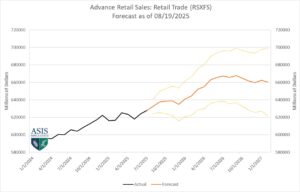Inventory Stockouts or Discount and Markdown Risks?
Posted By : Armada Corporate Intelligence | Date : September 17, 2025I get a lot of questions about my views on inventory. For context, we can point to many business cycles over the past 30 years and we can find correlations between inventory-to-sales-ratios and boom/bust cycles across transportation and logistics, manufacturing, retail and other industries. But the question remains headed into Q4, are we going to face stockouts or overstocks?
The market narrative is that we are facing overstocks because companies got way out over their skis and ordered products to avoid tariffs and now they sit with too much inventory on hand and a tepid consumer. That just doesn’t fit the data and market reality, however.
I did a comprehensive deep dive into data and assessments going back over the past 25 years and based on that assessment, data would point to a 65% chance this fall of stockouts and purchasing managers using expedited freight to fill those stockouts. That goes against the 35% chance of post-holiday markdowns and a hit to Q1 GDP.
Here’s what the model is factoring into its 65% estimate:
- Retailers’ fast-turn product categories are running 10%–20% below 2023 unit inventory levels. In short, for the critical basic product categories, retailers are sitting too light relative to historical peak norms.
- July/August retail sales (ex-gasoline) at +3.7% y/y, which is a solid consumption rate – despite some notable risk coming out of consumer sentiment and labor data. Labor-market cracks may curb spending—but history shows claims need 2–3 months above 270 k before holiday budgets are cut sharply.
- Mid-September back-to-school clearance levels are lighter than expected; healthy sell-through points to stronger consumer spending and consumption and leans more heavily into the potential for stockouts and better sell-through in this peak season.
- If the Federal Reserve follows through with expectations for 3 quarter-point rate cuts, that could also help trim credit card interest rates and boost some spending.
- Any refinancing activity for mortgages can free up an estimated $150-$300 a month in consumer discretionary spending.
- Lastly, we don’t know what impact the tax bill will have on consumer spending. As the administration makes the impact to average consumers from the tax bill clearer, many will spend before they get the benefit from tax savings. We call that animal spirits in economics. And we know that those public relations campaigns are in the works right now within the administration, and a better educated consumer will likely start spending at a more rapid pace knowing the benefit its coming.
Most of the models in the Watch (at the back of the Flagship report) would support more aggressive outlooks on consumer spending. The model below for consumer retail spending shows that the prediction (solid orange line) and the downside scenario estimate (the dotted orange line on the lower side of the graph), both show good optimism. The model (which incorporates 18-22 economic measures in the prediction) is not showing downward bias based on what it sees in the economy at this time. This could change, but for now, the outlook is stable and optimistic. – KP

